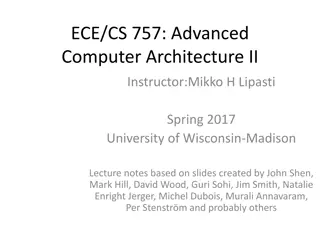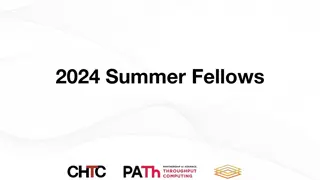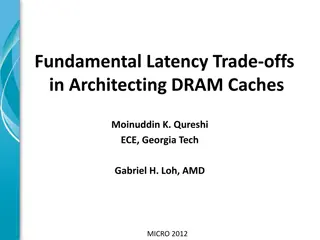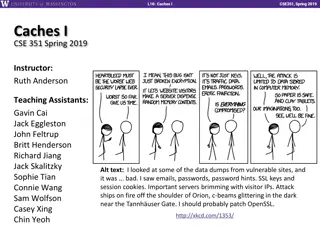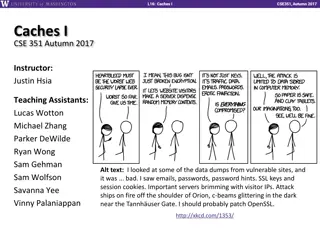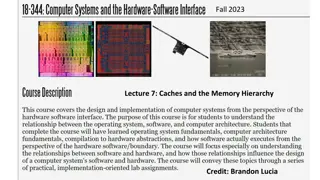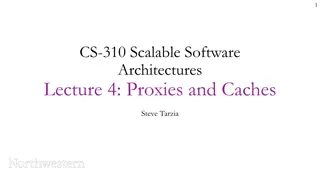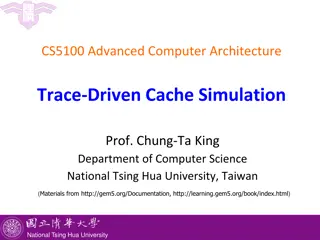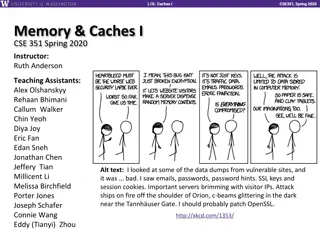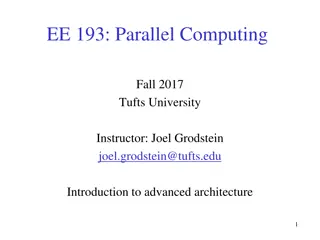Delving into Advanced Caches: A Comprehensive Overview
Let's dive deeper into the intricate world of processor memory systems, focusing on L2 caches, cache modeling, simulation using tools like Cacti, cache structure, and optimization techniques. Explore the nuances of cache design, from SRAM cells to sub-array configurations, and understand how Cacti works to create efficient cache designs.
Download Presentation

Please find below an Image/Link to download the presentation.
The content on the website is provided AS IS for your information and personal use only. It may not be sold, licensed, or shared on other websites without obtaining consent from the author.If you encounter any issues during the download, it is possible that the publisher has removed the file from their server.
You are allowed to download the files provided on this website for personal or commercial use, subject to the condition that they are used lawfully. All files are the property of their respective owners.
The content on the website is provided AS IS for your information and personal use only. It may not be sold, licensed, or shared on other websites without obtaining consent from the author.
E N D
Presentation Transcript
Ms.Prabha Batwal Biology Lecturer
INHERITANCE AND VARIATION Inheritance-It is the transmission of genetic information from generation to generation. Gregor Mendel first gave the explanation for the mechanism of inheritance by Hybridization technique. Seven traits in garden pea were studied individually, combination of 2 or 3 character at a time.
Reasons foR Mendels success The experiments were carefully planned and involved large sample. The results were expresses in ratios. In pea plant the Contrasting characters can be easily recognized. All characters controlled by single factor, that transmitted from generation to generations. He introduced the concepts of dominance and recessiveness.
Genetic terminology Character: Specific feature of an organism e.g. height of stem Traits: Inherited character e.g. Tall or dwarf Factor: Unit of heredity Gene: Particular segment of DNA Alleles: Alternate form of a gene 6. Dominant: Allele that express its traits 7. Recessive: Allele that can t express in presence of an alternative allele 1. 2. 3. 4. 5.
8. Phenotype: External appearance of an individual for any trait 9. Genotype: Genetic constitution of an organism with respect to a particular trait. 10. Homogygous(pure): Identical alleles & produce only one type of gametes e.g. Tall(TT) Dwarf (tt) 11. Heterozygous: Contrasting alleles e.g. Hybrids(Tt)
12. Pure line: An individual is homozygous for one or more traits 13. Monohybrids: Its heterozygous for one trait and is produced from cross between two pure parents differing in single pair of contrasting characters. 14. F1(filial) generation: Consists of all off springs produced from parental cross. 15. F2 generation: Second generation produced by selfing of F1 generation (e.g.Tt x Tt).
16. Punnett square/ Checker board: It is a probability table representing different permutation and combination of fertilization between gametes to predict the progeny. 17. Homologous chromosomes: Morphologically, genetically and structurally identical chromosomes present in diploid cell. 18. Back cross: Cross of F1 progeny with any parent (e.g. Tt x TT/tt) 19. Test cross: Cross of F1 progeny with homozygous recessive parent (e.g. Tt x tt)
20.Phenotypic Ratio: Physical appearance of off springs in F2 and subsequent generations e.g. F2 Phenotypic ratio in monohybrid cross is 3 tall:1 dwarf (3:1) 21. Genotypic Ratio: ratio of off springs with respect to their genetic makeup e.g. F2 genotypic ratio in monohybrid cross is 1 TT: 2 Tt: 1 tt (1:2:1) 22. Monohybrid cross: Cross between parent differing in only one pair of contrasting character. 23. Dihybrid cross: Cross between parents differing in two contrasting characters .
Yellow/Round Green/Wrinkl e
Mendels law of InheRItance 1. Law of Dominance 2. Law of Segregation 3. Law of Independent assortment
Law of Dominance When two homozygous individuals with one or more sets of contrasting character are crossed, the alleles(character) that appear in F1 are Dominant and which do not appear are Recessive.
Law of Segregation(Law of purity of gametes) The law states that when hybrid form gametes, the alleles segregate from each other and enter into different gametes. The gametes formed are pure that they carry only one allele each(either dominant or recessive allele) .
Law of Independent Assortment The law states that when hybrid possessing two (or more) pairs of contrasting factors form gametes, the factors in each pair segregate independently of the other pair. This law is based on Dihybrid cross.In that cross Phenotypic ratio is 9:3:3:1 indicates that two pairs of character behave independent of each other.
Yellow/Round Green/Wrinkl e
devIatIons fRoM Mendels fIndIngs A number of deviations were identified in the post- Mendelian era, that gave additional information about the pattern of inheritance. These deviations are then described as Neo-Mendelism. It was observed that the phenotypic expression of the gene can be modified or influenced by other gene. Two type of interactions are there.
Intragenic intercation Occur between the allele of same gene. E.g. Incomplete dominance & Co-dominance Intergenic interaction Occur between the alleles of different genes present on same or different chromosomes. E.g. Pleiotropy, Polygenes,Epistasis, Supplementary and Complementary genes











